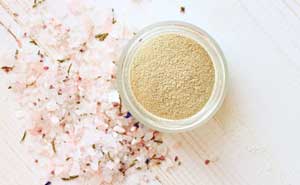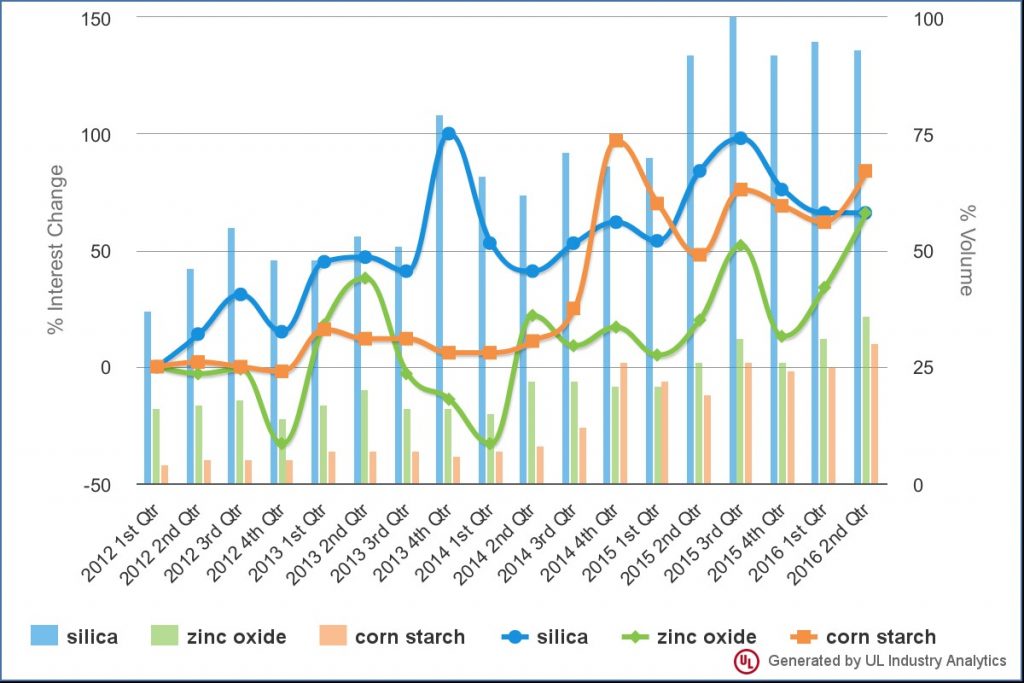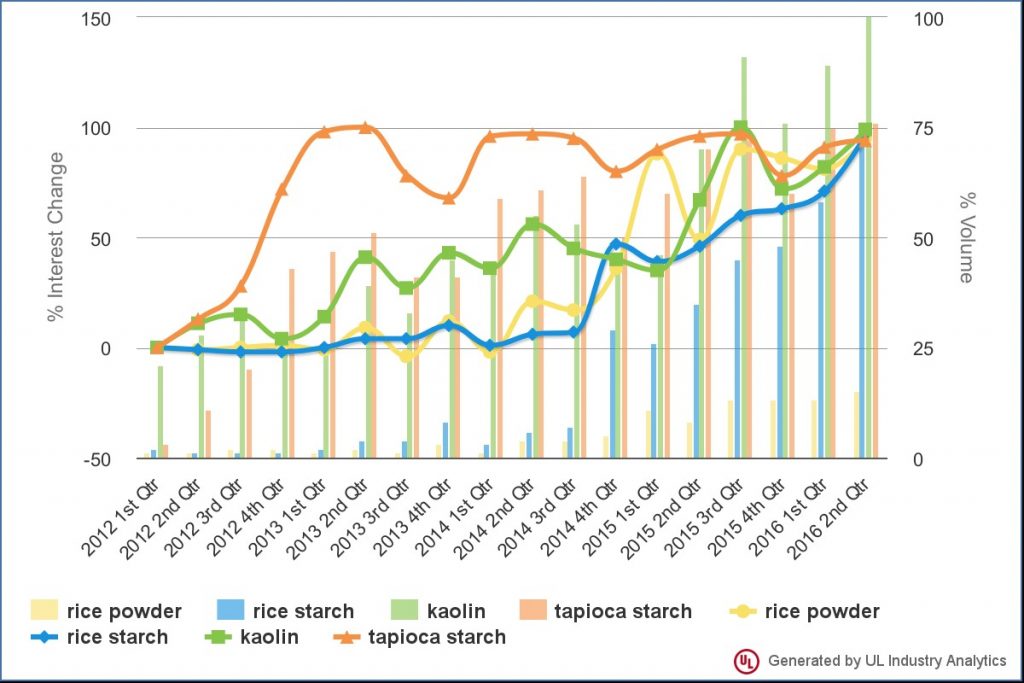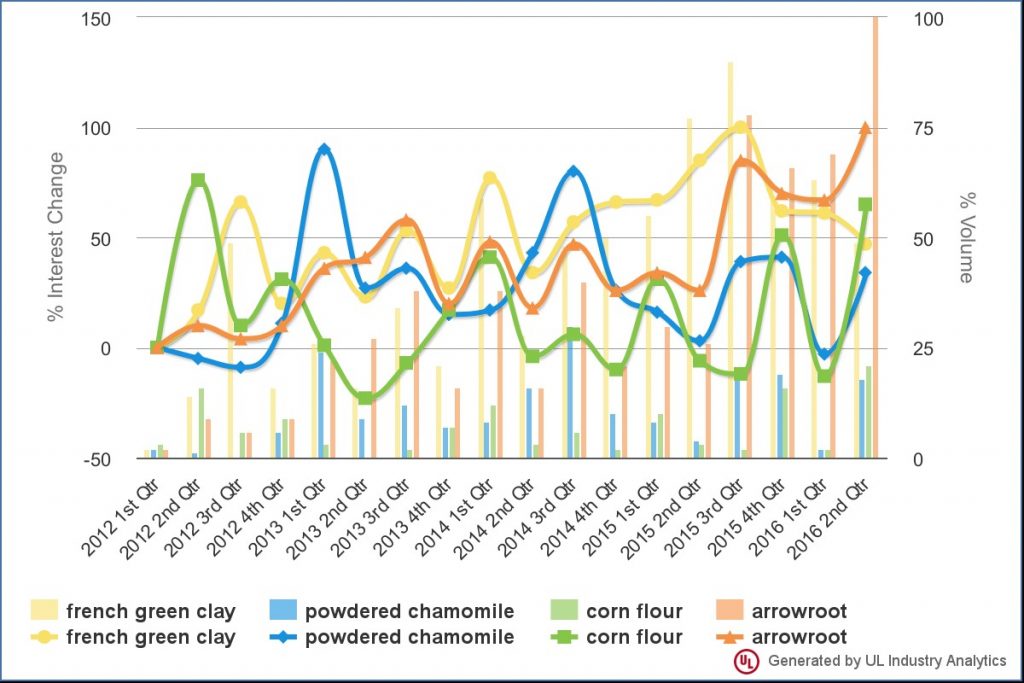 Summary:
Summary:
As institutional trust erodes and the internet offers new layperson pathways for research and discussion, cosmetics consumers are actively seeking products made without controversial ingredients. Talc is one of the most contentious ingredients of 2016, and UL’s Industry Analytics is tracking a parallel rise in search volume and interest for alternatives to the absorbent ingredient.
In addition to consumer worries, formulators may also want to avoid talc to increase their products’ global reach: talc is now restricted in the EU. So what alternatives are formulators searching for? The most popular talc alternatives are silica, zinc oxide and corn starch, with smaller-volume talc-alternatives searches showing relatively big jumps in interest, as well, including rice starch, tapioca starch, kaolin and rice powder.
Public Concern
As institutional trust erodes and the internet offers new layperson pathways for research and discussion, cosmetics consumers are actively seeking products made without controversial ingredients. Talc is one of the most contentious ingredients of 2016, and UL’s Industry Analytics is tracking a parallel rise in search volume and interest for alternatives to the absorbent ingredient.
Talc concerns began decades ago and centered around asbestos contamination. Manufacturers began testing (and certifying) their ingredients; talc labeled asbestos-free is now used in a wide variety of personal care powders and cosmetics. But many consumers are still wary of possible asbestos links. Although the FDA has done small studies that posit talc is indeed asbestos-free in the U.S., the agency suggests more thorough research needs to be done to prove those claims to consumers.
Talc concerns spiked again this spring when Johnson & Johnson was ordered to pay $127 million in damages in two court cases brought by the families of women who died of ovarian cancer—and who also used the company’s talc-based products for decades. 1,200 similar suits are still in process. The plaintiffs’ lawyers theorized that talc particles can travel into the reproductive system and cause inflammation that eventually leads to cancer.
Attorneys for the plaintiffs presented jurors with a study linking talc use to higher ovarian cancer rates. (The lead author is also a paid consultant for the plaintiffs’ team.) But according to respected organizations like The American Cancer Society, the totality of scientific research on the subject is far from conclusive.
Reporting on the lawsuits, the L.A. Times writes, “It’s unsurprising that the public, and jurors, don’t know who to believe, if anyone.”
When the evidence is divided and complex, consumers often choose to err on the safe side and avoid the ingredient altogether. The Cosmetic Compliance Summit’s recent report on taboo ingredients encourages formulators to pay attention to consumers’ concerns.
“Many consumers are beginning to read up on what exactly is in their products, and how they are tested and produced,” the report says. “Companies which are not adapting to these trends will run the risk of losing market share and possibly hurting their public image.”
In addition to consumer worries, formulators may also want to avoid talc to increase their products’ global reach: talc is now restricted in the EU.
Trending Talc Alternatives
So what alternatives are formulators searching for? The most popular talc alternatives are silica, zinc oxide and corn starch. Silica has seen the most search growth over the past four years.

But smaller-volume talc-alternatives searches are showing relatively big jumps in interest, too. Both rice starch and tapioca starch had minimal searches in 2012 and now are biting the heels of the popular clay kaolin. Rice powder searches have grown as well, if more slowly.

More niche alternatives, often championed by naturally minded DIY-ers, are also showing search growth, including French green clay, powdered chamomile, corn flour and arrowroot.

Learn more about talc alternative search trends
UL's dynamic Industry Analytics tool for the Personal Care & Cosmetics Industry draws on actual behavioral search data from industry professionals.
| Sponsored Products |
| Makrolon® LED2643 |
| Makrolon® LED2245 |
The views, opinions and technical analyses presented here are those of the author or advertiser, and are not necessarily those of ULProspector.com or UL Solutions. The appearance of this content in the UL Prospector Knowledge Center does not constitute an endorsement by UL Solutions or its affiliates.
All content is subject to copyright and may not be reproduced without prior authorization from UL Solutions or the content author.
The content has been made available for informational and educational purposes only. While the editors of this site may verify the accuracy of its content from time to time, we assume no responsibility for errors made by the author, editorial staff or any other contributor.
UL Solutions does not make any representations or warranties with respect to the accuracy, applicability, fitness or completeness of the content. UL Solutions does not warrant the performance, effectiveness or applicability of sites listed or linked to in any content.



How about silk powder and pearl powder?
Talc is regulated in the EU, but not restricted. On powdery products intended to be used for children under 3 years of age, the wording “Keep powder away from children’s nose and mounth” is mandatory, but here is no restriction on the use of talc.